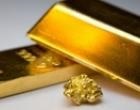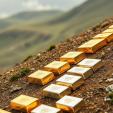$1,973 Gold Price by Year-End If January Gain Holds As Annual Average

 If the 5.3 per cent increase in gold prices holds as the monthly annual average gain for 2016, then gold will be $1,973 an ounce by the end of the year.
If the 5.3 per cent increase in gold prices holds as the monthly annual average gain for 2016, then gold will be $1,973 an ounce by the end of the year.
That’s the power of compounding if you take what many thought a very modest performance by the yellow metal in a month of extraordinary instability in global financial markets led by a plunge in Chinese equities and new lows for oil.
Gold Prices Jump
Physical gold mainly led the precious metals’ complex. Silver managed about half its price increase while the GDX and GDXJ exchange traded products lagged further behind.
That said an index of South African gold mining stocks was up 35 per cent while some individual gold juniors showed spectacular recoveries from over-sold lows. So for traders there still seems to be plenty of room to gear-up by investing in the other boats that will rise with the tide of higher gold prices.
But one of the biggest events of the month only came on the last trading day. The decision to introduce negative interest rates for the first time in Japan.
This wrong-footed the many hedge fund and other major investors who treat the yen as a safe haven. Perhaps it is a lesson they will not forget.
Safe Haven
As an alternative safe haven gold may not pay any interest, but it is not going to charge you interest for holding it, like the yen from Friday onwards. Gold prices did rebound from a bout of profit taking at the end of the month but the wider impact was not immediately priced in.
Remember the Goldman Sachs argument for shorting gold in 2015 was that higher interest rates are coming around the world so gold is bound to fall because it pays zilch? Reality is proving very much the reverse is now true.
Already in the final week of January we saw a spike in the gold price to $1,127 on Wednesday as the market digested the latest waffle from the Federal Reserve and concluded this meant rate increases are less likely in 2016. Friday’s action by the Bank of Japan can only have kicked this particular policy ball into even longer grass.
Gold is quietly emerging as the best safe haven play for 2016, just a month after being heavily slated by market commentators. One reason for the deafening quiet is that the Wall Street pack is loathed to admit it got this so wrong, and the younger and less experienced just can’t quite work it out.
Wall Street’s Folly
Maybe they will still be scratching their heads at the end of February after another surprisingly positive month for gold. Those holding yen as the world’s third biggest reserve currency are bound to be wondering where to put their money now for safe keeping after the walloping the yen took on Friday.
The Chinese wanting to move money as fast as possible out of their devaluing currency now have one less safe haven in which to hide. Really given Japan’s record as by far the weakest major economy in recent years this was always an accident waiting to happen and now it has.
However, the most immediate opportunity for investors in the gold complex is probably not the yellow metal itself in physical form but the fellow travelers who tend to rise alongside: gold stocks and silver in particular.
Consider the physical metal as a pioneer braving the new frontier and taking out a few indigenous people along the way, clearing a path for those who follow.
Silver Lackluster
If this runs true to form then silver prices will advance at twice the rate of gold. The gold-to-silver ratio is very stretched at the moment and usually shrinks as the gold price rises. That’s because silver is a much tighter market for supply and demand than gold.
Gold producers and the junior exploration companies have an even more obvious leverage to the gold price as their costs remain static while the value of their output and, or reserves go up. Indeed the effect of devaluation in many commodity currencies on local costs has already given these guys a boost that is not yet reflected in their share prices.
This much we can see now. The known knowns. But there are some intriguing known unknowns in the precious metals’ complex.
What does it mean when the physical gold covering trades in the Comex futures market is down to two tonnes, implying almost infinite leverage? Silver is also extremely stretched. And the Shanghai exchange is similarly empty.
The only logical explanation is that the participants think the paper market is on the verge of collapse and have withdrawn every ounce of physical metal that they can get their hands on. Now what would it mean for prices if the Comex collapsed?
Price Spike Coming
Well the central bank manipulation of the gold price that has stopped it rising in line with general price inflation for decades would be over. In short, the price would recalibrate much higher. How much higher?
Certainly a lot higher than the $1,973 that I number crunched from the January gain - by coincidence or not an exact return to the all-time high of 2011. But will this actually happen? Falling physical cover in the futures markets is not a new phenomenon and nobody knows precisely when it will become or problem, or when presumably somebody will try to fix it.
The other great known unknown is how the bursting of the debt and bond mountains around the world will play out this year. Again gloom-and-doomsters have been writing about this for many years and we are still waiting.
What we do know from historical parallels is that when debt and bond bubbles crash then the best asset class to be left holding is always precious metals. In that context the gain of 5.3 per cent in the gold price in January looks very modest, and compounding up to $1,973 for the whole year is far from fanciful.
********
Free Gold-Eagle Newsletter!
- Fresh weekly insights on gold, precious metals, and the economy
- Leading authors from around the world
- Always free
- Stay informed!

















